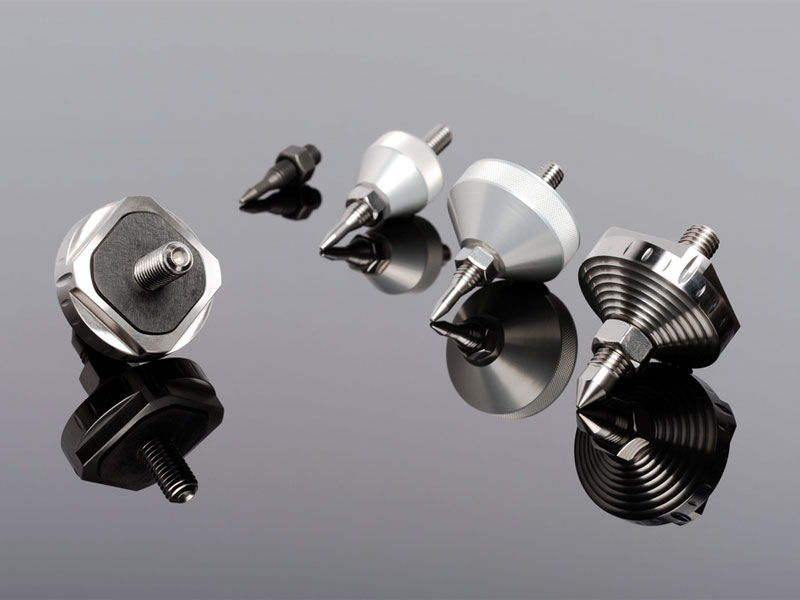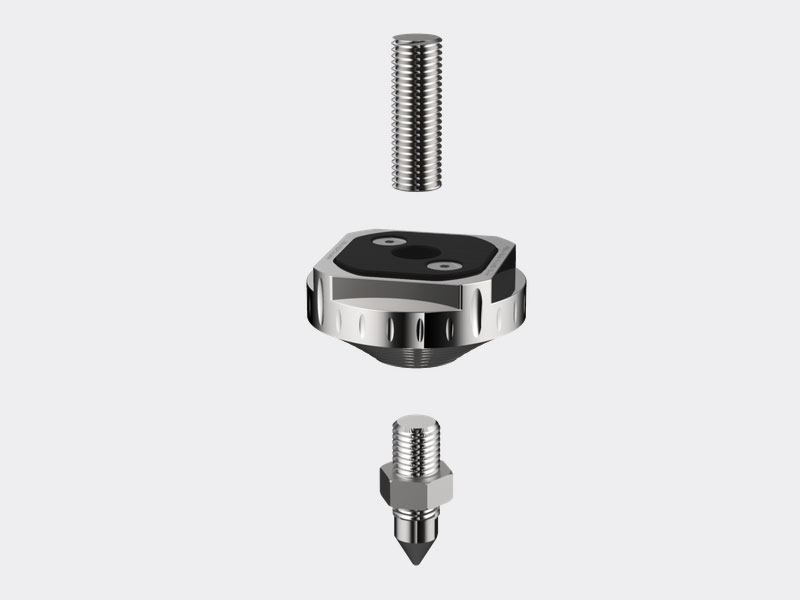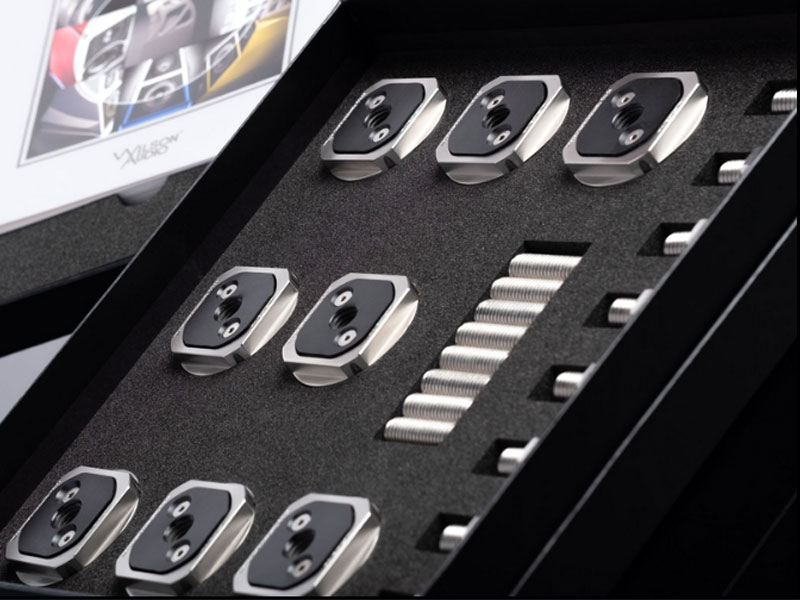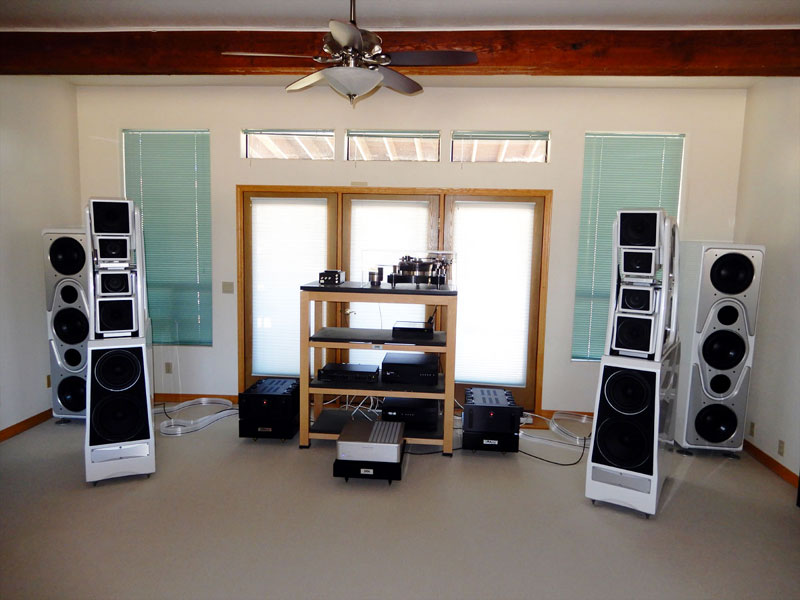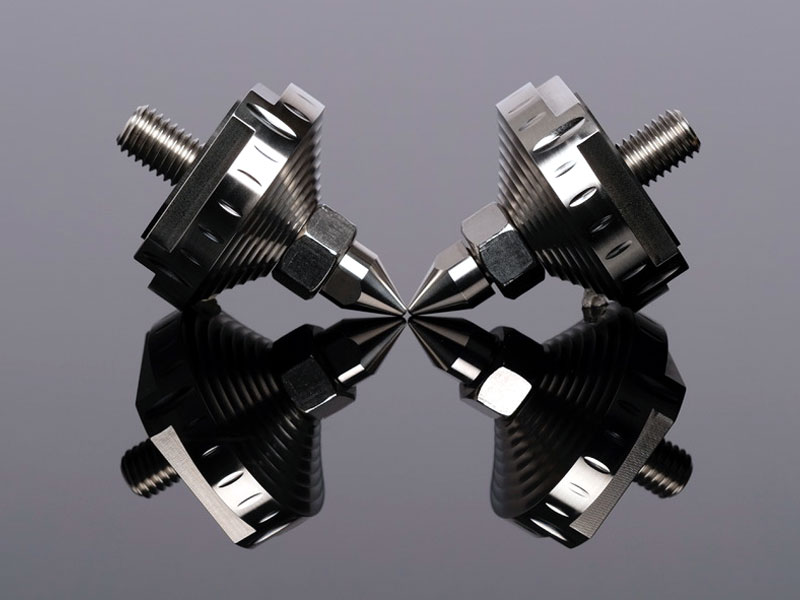First Sounds: Wilson Audio Acoustic Diode
ne of the delights of living with the Wilson Audio Chronosonic XVX speakers, which I reviewed early last year, has nothing to do with the wonderful, visceral music they make. Rather, it's completely visual: the way light plays off the speakers' many facets and angles. My personal favorites of these are the sides of the woofer cabinets, which are the speakers' largest contiguous surfaces. Each side could easily be a plain, flat panel, but, for the XVX, they have some artful touches, including a trio of "swoops," as I call them. These are nearly imperceptible (and essentially invisible in certain circumstances), but if you run your hand over the side of the woofer cabinet, you can feel them. In low light, you can barely see them, but in the right light, which occurs in the morning in my listening room, they almost seem to twinkle and dance. This fine aesthetic point is no coincidence; it's the product of a considered thought process that didn't begin with the XVX. I saw the first signs of it with an earlier Wilson speaker -- not identically but in spirit. When the original Alexia was upgraded to the Alexia 2 in 2018, the new speaker's back panel looked considerably different -- and considerably better. I described it in my review as "sleek and high-tech," with the resistors used to tailor the speaker's frequency response shown behind an aluminium-and-glass panel, "giving it more than mere visual hints of a luxe sports car." This time, given the access to the speaker's resistors and the tailoring of the sound they provide, I can't say that the Alexia 2's back panel was only an aesthetic touch, but it was the beginning of a trend toward greater refinement of Wilson speakers. Anything and everything, it seemed, was up for debate and improvement. So chalk up another thing that Daryl Wilson and his team do well: refine. This brings me to Daryl Wilson's latest refinement and also one that leads to more refined sound. The name Acoustic Diode may seem a bit obscure, given that we're talking about the spike assemblies on which Wilson Audio speakers sit, but it does describe the function of these multipiece accessories. In electrical terms, a diode allows the flow of current in one direction only, and the Wilson Acoustic Diode does the same thing with energy from speaker cabinets, channeling it down into the floor.
The evolution of Wilson Audio's spiked footers. While the Acoustic Diode is a new product, it is also a refinement of an existing product. David Wilson, Daryl's dad, invented the four-piece speaker spike assembly in the early 1990s for the X-1 Grand SLAMM -- the original super-sized speaker with a super-sized price. This comprised a post that screws into the speaker cabinet and the top of the assembly's machined conical body, a threaded spike that screws into the bottom of the body, and a jam nut that locks the spike in place. The whole thing threads into the X-Material bottom plate of the speaker. Once the speaker is leveled, the nut threaded onto the spike is tightened against the body, securing the spike in place. X-Material, which was first used in the Grand SLAMM, enabled the invention of the spike, due to the material's inherent hardness and strength. The threaded receptacle could be milled and tapped directly into the speaker's X-Material bottom plate. Prior to X-Material, a brass insert served as the spike receptacle. While Dave Wilson invented the spike specifically for the X-1 Grand SLAMM, the WATT/Puppy Series 5, which was contemporary to the X-1, also used a smaller version of it, called the Puppy Paw. Every Wilson floorstanding speaker since has included these four-piece spikes.
Fast-forward to today's Acoustic Diode Upgrade Kit ($3200). This comprises a set of eight seven-piece footers, each weighing 12 ounces, which were launched in conjunction with the Alexx V speakers. The Acoustic Diode looks similar to the earlier four-piece Wilson Audio spikes, but there are some important -- and clever -- refinements, the most obvious being the black material you see on top of the Diode's widest part. This is an inset piece of Wilson Audio's V-Material, held tight to the body with a pair of countersunk hex head screws. The V-Material acts as the interface with the bottom of the speaker. Why this material and not, for instance, Wilson's X-Material? This is exactly the question I asked Blake Schmutz, Wilson Audio's materials engineer: "V-Material exhibits superior vibration absorption and damping characteristics compared to our already outstanding X- and S-Materials . . . both removing energy from the loudspeaker enclosure as well as preventing energy transmission from the environment, specifically the floor." Why, then, not make the Acoustic Diode's entire body from V-Material? "It would not provide sufficient strength on its own to handle the load of our loudspeakers. X-Material is sufficiently strong, but V-Material surpasses X-Material in energy absorption and dissipation."
The Acoustic Diode comes standard with the WAMM Master Chronosonic and the Chronosonic XVX, in addition to the Alexx V. However, if you own another Wilson speaker, or a speaker from a different manufacturer, Wilson Audio has you covered. Available thread sizes are 1/2"-13 (for all current Wilson Audio speakers) and 3/8"-16 (for most retired Wilson speakers); Wilson also offers adapters for other speakers, currently 5/16”-18, M8, M10, M12, and M14 -- more on this below.
For more than a year, I used the Acoustic Diodes with both the Wilson XVX speakers and Subsonic subwoofers, and with three pairs of non-Wilson speakers, all of which constituted a very diverse group of test subjects. I installed, uninstalled and reinstalled the Acoustic Diodes many times, which is no quick process, especially with either the XVXes or Subsonics. I had to lift each end with the jack that Wilson includes with its large speakers, remove the existing spikes or Acoustic Diodes, install whichever was not in use, and then repeat for the other channel. It's more than a bit harrowing to do this for a speaker or tall subwoofer that could tip over, possibly on top of you. But it was necessary in order to understand the effect of the Acoustic Diodes, especially compared to the four-piece spikes that came at the time with the review pairs of XVXes and Subsonics. Before the Acoustic Diodes arrived, and while I was installing and uninstalling them, I pondered two questions. First, are the Acoustic Diodes a worthwhile upgrade for Wilson Audio speakers, and, second, are they a worthwhile upgrade for speakers from other makers? You might think the answer to the first question is straightforward, given that the Acoustic Diodes are Wilson Audio products. But no speaker maker has done more research and experimentation on cabinet materials than Wilson Audio, and all of this was done to understand the effective dissipation energy from speaker cabinets -- just what the Acoustic Diodes are designed to do. And, as already mentioned, David Wilson invented the four-piece footer, which Wilson Audio still offers, decades ago, and it's similar to the Acoustic Diode of today. All of this caused me to wonder if the Acoustic Diode would be at best a small improvement -- and perhaps no improvement at all. With non-Wilson speakers, I also wondered if the technology developed by one company would benefit speakers from another, or would it be more a lateral or backward move. I needn't have worried. With the XVXes and Subsonics, the Acoustic Diodes were wholly positive and worthwhile upgrades. Instrumental lines were more distinct, especially from the midbass on down, and the sound was lighter, as in filled with light, and more crisp -- in the best sense. One important question was whether the Acoustic Diode was a more significant upgrade for the XVX or Subsonic. In a certain sense, Wilson Audio itself answered this question: it now includes Acoustic Diodes with XVXes. However, no one buys products like the Subsonic without wanting to wring the very most performance from it, and a set of Acoustic Diodes underneath will facilitate this. However, it was the non-Wilson speakers I had on hand, especially the smallest and least expensive pair, that benefitted most from the Acoustic Diodes. By a stroke of luck, I received pairs of JMlab Utopias and Mezzo Utopias just as the Acoustic Diodes showed up. These are the original models, gloss black with wood accents, from around 1998, not the newer, and much more expensive, models. A longtime friend of mine has used original Utopias as his reference speakers for nearly two decades, even though he could buy others. The cabinets of both are well braced and heavy, made of MDF and hardwood and damped internally with lead. Each section of the speakers is separate from the others, a detail that is hard to see in photos. In their design and construction, these twenty-year-old speakers fit right in today. Both speakers have M8 inserts for spikes, which is small for such heavy speakers, but on the bottom of the much larger and heavier Utopias the inserts are recessed and near the corners. The Acoustic Diode's top is too wide to use them with the Utopias without something in between, which compromises contact between the speakers and the top of the Acoustic Diodes. But use I did, inserting donut-shaped Delrin spacers to make up the gap between the M8 inserts and Acoustic Diodes' top surfaces. Even in this configuration, the sonic improvements over the spikes I was using were transformational. Like fine-tuning the focus of a spotting scope, the sound of the Utopias was sharper and better delineated from top to bottom. Soundstage depth was improved as well. However, it was with the Mezzo Utopias, which have a flat bottom, that the Acoustic Diodes did their very best work. The Mezzos are smallish floorstanders that sound big and very rich in the bass, bordering on too rich. However, once the Acoustic Diodes were installed, the bass became truly powerful, displaying Wilson-like weight, heft and definition. Into the midrange and treble, the sound was again more focused and, interestingly, more relaxed, as though the speakers were remastering each recording, revealing buried detail while also taking any edge off the treble. With the Utopias in mind, I asked Blake Schmutz if Wilson will offer other sizes of Acoustic Diodes. "That is a possibility we could explore in the future, depending on need and demand," he answered. Explore, please. I would love to hear what the proper use of the Acoustic Diodes would uncover from the JMlab Utopias. More recently, I've been using Acoustic Diodes with a pair of Stenheim Ultime Three speakers, whose all-aluminum cabinets seem, inch for inch, a bit heavier than even Wilson's composite cabinets. The Acoustic Diodes became the go-to spike for these speakers because they pierce the carpet and pad in my listening room, which the broader, somewhat mushroom-shaped Stenheim footers do not (they would be kinder to wood and tile floors, however). I can't make definitive statements about the Acoustic Diodes with the Stenheim speakers, except to say that they greatly improve the low-end definition and heft over the furniture sliders they replaced. More on the Stenheim speakers to come. As for using the Acoustic Diodes with speakers other than those from Wilson Audio, put in your order now and get ready to hear all that your speakers are capable of.
The Acoustic Diode is a product of
Daryl Wilson's restless audio soul (along with the Pedestal, which continues to impress), but it's also one that builds
on his dad's forward-thinking design work and does so in ways that are easy to hear. If
you have a pair of speakers you love, from Wilson Audio or especially another maker, a set
of Acoustic Diodes is an all-gain refinement to their sound. |

